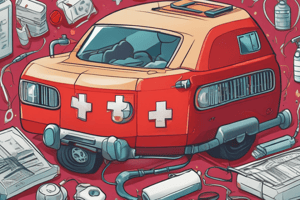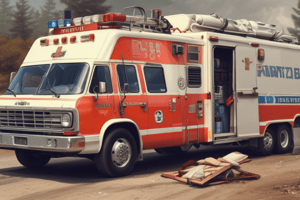Podcast
Questions and Answers
What is the major killer worldwide when it comes to sudden cardiac arrest?
What is the major killer worldwide when it comes to sudden cardiac arrest?
sudden cardiac arrest
What percentage of sudden cardiac arrest victims survive?
What percentage of sudden cardiac arrest victims survive?
- 30%
- 5% (correct)
- 10%
- 20%
Sudden cardiac arrest occurs when the heart starts beating chaotically and is able to pump blood to the body.
Sudden cardiac arrest occurs when the heart starts beating chaotically and is able to pump blood to the body.
False (B)
SCA is the result of an electrical malfunction of the _____.
SCA is the result of an electrical malfunction of the _____.
Match the following causes with Sudden Cardiac Arrest:
Match the following causes with Sudden Cardiac Arrest:
What does AED stand for?
What does AED stand for?
Semi-automatic External Defibrillator requires only one button operation.
Semi-automatic External Defibrillator requires only one button operation.
Fully Automatic External Defibrillator requires two-button operation.
Fully Automatic External Defibrillator requires two-button operation.
What is the purpose of ACLS (Advanced Cardiac Life Support)?
What is the purpose of ACLS (Advanced Cardiac Life Support)?
What does the 'Chain of Survival' refer to in the context of Sudden Cardiac Arrest?
What does the 'Chain of Survival' refer to in the context of Sudden Cardiac Arrest?
What type of support is emphasized in the message for all?
What type of support is emphasized in the message for all?
Flashcards are hidden until you start studying
Study Notes
Sudden Cardiac Arrest (SCA)
- SCA is a major killer worldwide, with over 250,000 deaths per year in the US alone.
- Only 5-10% of its victims survive.
- Every two minutes, someone suffers from SCA.
Incidence of SCA vs. Other Main Causes of Death
- SCA accounts for more than 50% of cardiac mortality.
- Autopsies revealed that 90% of victims have Coronary Artery Disease (CAD).
- The incidence of SCD is 150 per 100,000 persons annually in industrialized countries.
- 40% of SCDs occur in people with no prior history of heart disease.
Risk Factors of Sudden Cardiac Death (SCD)
- Prior episode of Ventricular Tachycardia (V.TACH)
- Low Left Ventricular Ejection Fraction (LVEF)
- Previous Myocardial Infarction
- Coronary Artery Disease
- Family History of SCD
- Cardiomyopathy
- Congestive Heart Failure
- Long QT Syndrome
- Right Ventricular Dysplasia
Treatment of SCA
- "Chain of Survival" consists of:
- Early access
- Early CPR
- Early defibrillation
- Early advanced life support
Early CPR
- Determine if the patient is conscious or not by placing one hand on the patient's forehead and shaking their shoulders gently with another hand.
- If the patient is not responsive, start CPR.
- Steps preceding CPR include:
- Determining the A, B, C of Basic Cardiac Life Support (BCLS)
- Airway:
- Head tilt
- Finger sweep
- Jaw Thrust
- Breathing:
- Look: down the line of the chest to see it rise and fall
- Listen: at the mouth and nose for breathing sounds
- Feel: for expired air at the patient's mouth and nose
- Circulation:
- Feel: carotids
Cardiac Compressions
- Locate the correct chest compression site, 2 fingers above the xiphoid.
- Place the heel of the other hand on the lower end of the breastbone.
- Fingers should be off the chest wall.
- Continue compressions until the AED is available.
Early Defibrillation
- CPR saves time, but the most common cause of SCA is Ventricular Fibrillation (VF), which can only be treated with defibrillation.
- The treatment goal is to defibrillate within 3 minutes anywhere in the hospital.
- Time is the enemy: the success rate of defibrillation decreases by 7-10% every minute delayed.
Automated External Defibrillators (AEDs)
- AEDs are well-suited for use by non-traditional responders, such as flight attendants, firefighters, and corporate emergency response teams.
- Today's AEDs are more practical for use in the workplace and public places, with voice prompts and self-tests that are virtually maintenance-free.
- Types of AEDs:
- Semi-Automatic: analyzes the patient's rhythm and advises if a shock is needed; the operator must press the "shock" button to deliver the shock.
- Fully Automatic: analyzes the patient's rhythm and delivers the shock if required, all by itself.
Importance of Early Defibrillation
- The American Heart Association (AHA) expanded its early defibrillation standard of care to include AEDs for in-hospital first responders in 1990.
- Resuscitation committees often emphasize the arrival of the core team rather than the delivery of the first shock.
- Treatment goal: defibrillation within 3 minutes anywhere in the hospital.
Studying That Suits You
Use AI to generate personalized quizzes and flashcards to suit your learning preferences.




